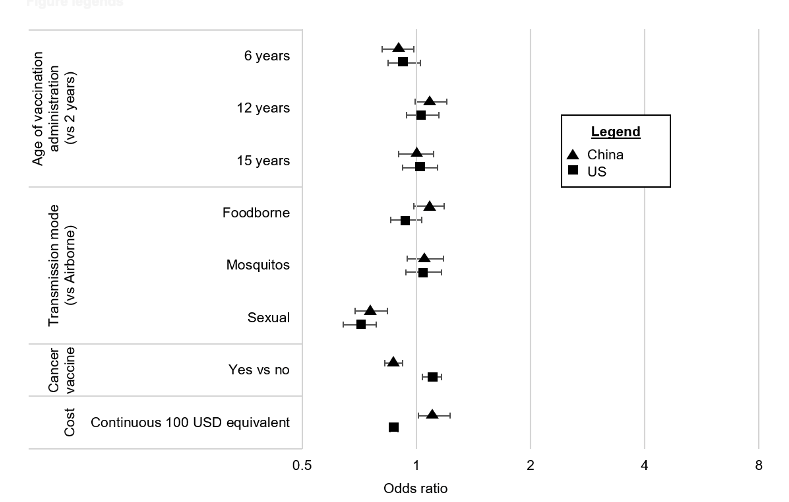ABSTRACT
Objectives: This study assessed preferences for hypothetical vaccines for children in two large vaccine markets according to how the vaccine-preventable disease is transmitted via a discrete choice experiment (DCE).
Methods: Surveys in China (N=1,350) and the US (N=1,413) were conducted April-May 2021. The DCE included attributes of cost, age at vaccination, transmission mode of the vaccinepreventable disease, and whether the vaccine prevents cancer. Preference utilities were modeled in a Bayesian, multinomial logistic regression model, and respondents were grouped by vaccine preference classification through a latent class analysis (LCA).
Results: Individuals favored vaccines against diseases with transmission modes other than sexual transmission (vaccine for STI vs airborne disease, in the US: OR: 0.71, 95% Credible Interval (CrI): 0.64, 0.78; in China: 0.76, 95% CrI: 0.69, 0.84). The LCA revealed six classes: vaccine rejecters (19% in the US and 8% in China), careful deciders (18% and 17%), preferring cancer vaccination (20% and 19%), preferring vaccinating children at older ages (10% and 11%), preferring vaccinating older ages, but indifferent about cancer vaccines (23% and 25%), and preferring vaccinating children at younger ages (10% and 19%). Vaccine rejection was higher by age in the US, versus more vaccine rejection among those 18-24 and ≥64 years in China.
Conclusion: The public had strong preferences against giving their child an STI vaccine, and the class preferring a cancer vaccine was less accepting of an STI vaccine. Overall, this study points to the need for more education about how some STI vaccines could also prevent cancers.
Keywords:
conjoint analysis; latent class analysis; human papillomavirus vaccines; surveys and questionnaires; immunization programs; stated choice experiment
Highlights:
-
Countries have had mixed success rolling out vaccines for sexually transmitted infections. For example, HPV vaccination lags behind Hepatitis B vaccination.
-
Individuals in the US and in China had consistently strong dispreferences for STI vaccines, although the two countries varied in terms of what proportion and what groups would reject vaccines altogether.
-
Roll-out of future STI vaccines should also consider preferences for when the vaccine be administered and what chronic diseases the vaccine prevents.
